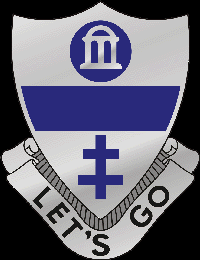
Bud C OlsOn

Bud C OlsOn
Many thank you to Bud Olson who wrote me a long letter to tell me its memories as well as to have joined me to this letter some photos...
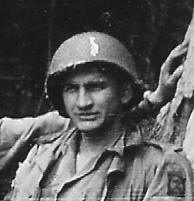
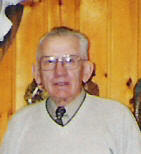
Bud Olson in June 1944 and in December 2007
My Memories of WWII
To back ground myself I was S/Sgt in Headquarters Company 3rd Batalion 325th Glider Infantry Regiment 82 nd Airborne Division.
I was classified as an intelligence Sgt. In charge of the intelligence platoon. I was sent to many schools prior to D Day. I was sent to SHAEF Hqs in London in January 1944. While there I spent three weeks studying the peninsula of Normandy.
I had to memorize every road, town location and all the German Fortifications and troop locations. I also had to study very carefully our proposed landing zone.
I was the only enlisted man from our battalion to attend the school… One officer also attended. There were many others there from different units in the class.
After returning to our base camp in Scraptoff England we had to hold classes every day on what we had learned in London. In looking back I was lucky to get this training. General Eisenhower used to come in and talk to us and question us on what we had learned while attending this school.
On may 24 1944 the 3rd Battalion moved to Exeter England where we mobilized for the invasion. I was ordered to ride in the leading glider of the 3rd Battalion. It was a Horsa glider… Made in England… #H14. 55 gliders were to follow us.
June 7, 1944 the 3rd Battalion loaded the gliders and at 0610 we took off for Normandy. It was my responsibility to tell the pilot where land. Riding in the glider were 28 men a pilot and co-pilot. I had to stand behind the pilot with my map of the Normandy country and when we reached the Utah beach at 0700 I was able to look down and view the beach.
I have often said that I was one of the very few who got to view the view below us. We encountered a lot of enemy fire as we were flying at 900 feet.
Our tow plane got hit and we had to cut loose and land within a very few seconds. We missed our designated landing zone.
We crashed landed near the town of Blosville. When we hit the ground our glider started to fall apart. I fell out as I didn’t have a seat belt on. The glider hit a grove of trees killing everyone. I was the only survivor.
When I came to I had a glider wheel on top of me. I was badly bruised and had a lot of cuts on my legs and torso. Gliders were landing all around us.
Within a few minutes enough of us secured the area and took German prisoners.
That afternoon Co K and L liberated the town of Blosville and Carquebut. A lot of prisoners were captured. Our 1st Command Post was in Chef du Pont.
June 8, 1944 we marched thru Ste Mère Eglise and established a Battalion CP somewhere along the Mederet River above the crossing at La Fiere. We were badly under strength.
On June 9, 1944 the 3rd Battalion was ordered to advance to the La Fiere crossing and attack across the Causeway and secure a bridgehead on the fare shore.
Our Battalion Commander, Col Carell who was badly injured in his glider crash objected to the order and was promptly relieved of his command.
Our Executive officer… Major Moore took over. As we approached the causeway under heavy cover we were met with intense enemy fire. The leading troops stalled as soon as they hit the road leading across the causeway. A Lt. by the name of Booker rose up and yelled “Follow me”. He was immediately hit by enemy fire and badly wounded.
The troopers in intense anger got up and knocked out a machine gun emplacement located on the left side of the La Fiere bridge over the Mederet River. The land on either side of the cause was flooded with water.
I can remember two Sherman tanks on the road… the leading one was disabled and the other one trying to get around it. I passed the tank just as it fired a round and the muzzle blast knocked me down.
We were under intense enemy fire and soldiers were either killed or wounded.
Major Moore was wounded and I dressed his wound, but he refused to be evacuated. I can remember General Ridgway walking the causeway and gathering the GI’s together to get up and fight.
I was in a group who knocked out a machine gun nest on the far shore of the crossing.
The 3rd Battalion CP was established across the causeway to the left in a stone courtyard.
That afternoon we had a German counter attack… we survived. That night after dark I was ordered to cross the causeway again and locate the leading elements of the 90th Division and lead them across the cause to their assembly area… they suffered causalities in crossing… I was lucky to get across again and not getting wounded.
The next day I was ordered to obtain an jeep and trailer and pick up our causalities on the causeway… it was a very say and disagreeable job… the next day Major Gardner took over the 3rd Battalion.
On June 13, 14 1944 the 3rd Battalion attacked St Sauveur le Vicomte. I was with Major Gardner and Capt. Mentlik and Pvt King who was a radio operator. We were in a shallow depression watching the troops attack across the valley. I became restless and moved a short distance. A mortar shell landed in the depression and killed the three… again I was the only survivor… Lucky????
June 15, 1944 Major Leahy was appointed our 3rd Battalion commander… We attacked across the Douve River near Etienville.
June 16, 1944 we moved to a defensive position near Pretot. I had to lead a night patrol on June 20th. The patrol got shot up with the wounded we got back to Battalion Headquarters with the information that we had gathered. I was awarded a Bronze star for that action.
June 22, 1944 I was promoted to Battalion Sgt Major. We went on the offensive again and attacked and liberated the town of La Poterie, La Dauderie et le Bois de Limors. A day later we liberated the town of La Haye du Puits.
The 3rd Battalion was relieved on July 12, 1944 and we returned to England.
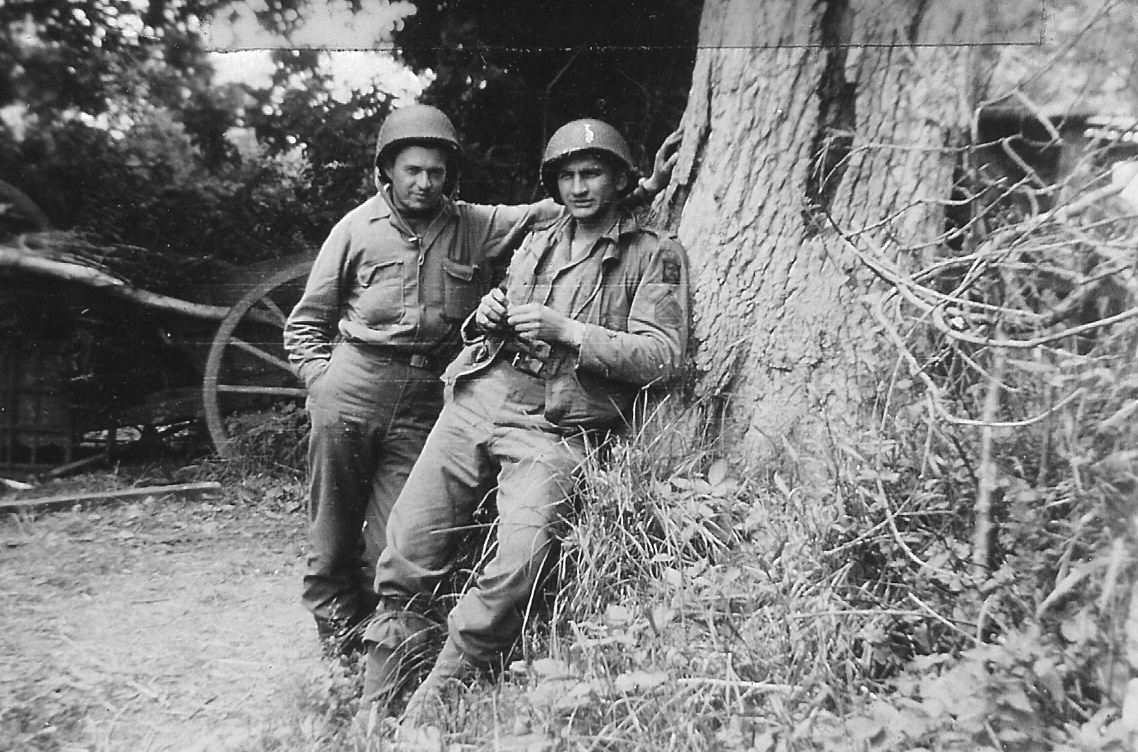
S/Sgt Olson à ça droite M/Sgt Weidmier, Normandie, France, juin 1944
We were in training again until August 31 1944. We were put on alert for the invasion of Holland. Due to bad weather we were held in a staging area until September 23, 1944. We then loaded up in a CG4A glider and took off at 12:30 pm. We only had one pilot, so I rode as Co Pilot. We circled the air strip for two hours attempting to get all the gliders airborne and in formation. The third hour we saw the coast of France. When we go down and two C-47 tow planes go down in flames, but we kept flying towards Holland and we landed in a potato field... perfect landing... but we landed in an area not yet in American hands. As soon as we landed a group of Dutch patriots gathered us up and hid us in different places until after dark. I was hid in a hay stack. After dark the Dutch patriots gathered us up and put us in a horse drawn water tank and proceeded to take us to a fire that they had started in the American sector. They delivered us to the American lines near Grave. We were put into a defensive position near Grosbeck Holland.
On Septembre 25, 1944 we were ordered to clean out the German guards in an area called the Kikeburg Woods. It was a heavily wooded area in a series of high hills. It was a tough battle... many of our troops were either killed or captured. That afternoon some German officers came to our command post under a white flag and asked our BN C.O. who as Col. Leahy to sureender to stop the killing of their and our troops. They would give us until 11 PM that night and then they would attack our lines and eliminate us. Col. Leahy refused. At that time my job was to keep a day by day journal of what happened. I wish I had that journal now. That night our command post was moved up to the front line. Everyone was to guard it as necessary.
That night we strung many grenades tied to trees with trip wires in front of our line. That night at 11 PM the Germans attacked under heavy artillery fire. We suffered a lot of casualties, but we didn’t surrender and we drove the Germans back.
On September 26, 1944 we were moved towards Mook for another battle. This was a very bad engagement with a lot of artillery and mortar fire. Again we suffered a lot of killed and wounded. We were relieved by a British unit of 0400 Oct. 2, 1944.
We were moved to Nijmegen to a rest area. While there I got to walk across the famed Nijmegen Bridge that spanned the Wall Canal. While we were in Nijmegen we had to go to house to house looking for hiding German soldiers. The Dutch people were a great help as they would tell us where the enemy was hiding. On November 13, 1944 we were relieved by a Canadian outfit and we moved to Bourg Leopold, Belgium and then we moved to Sissones, France to recuperate and receive replacements.
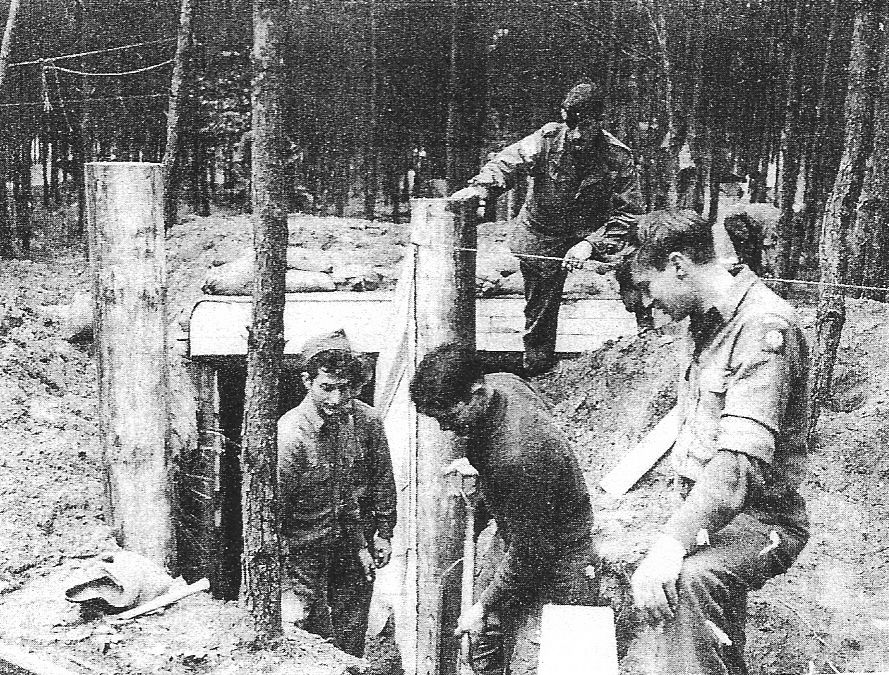
Extremely left T / Sgt Bud Olson with his companions in a Netherland's forest.
After midnight of December 17, 1944 we were alerted to get ready to move on a moment’s notice to go to Belgium near the town of Barveau as the German army had broken thru our lines and was travelling west towards the coast. We were loaded in open semi trucks without adequate winter equipment… It was a very cold ride.
On December 21, 1944 we were moved to Werbomont, Belgium and were ordered to set up a defensive position there. We were instructed to be wary of German soldiers wearing American uniforms and if we did not know the suspected person, we were to arrest him at gun point and turn him over to the closest MPs. A couple of nights later I was ordered to lead convoy of troops loaded in trucks to a new area. It was pitch dark and as we approached a crossroad, I knew was had to turn to the right. In the middle of the road a character dressed in an American uniform was directing us the wrong way. We knew we had a disguised German in American uniform… so a group of us… by gun point… arrested him. He could talk good English, but we took no chances and by gun point marched him the closest MP post… Only to find out he was our newly appointed Division C.O. That night in our Bn C.P. our officers were talking about the capture of our newly appointed Div. C.O. and they wondered who captured him. We never said a word… No one knew who captured him.
On January 3, 1945 we moved to attack Ordimont. It was very cold and snowing hard. A lot of German prisoners were captured here.
January 8, 1945 we were relieved by the 75th Division and we moved to Pepinster, Belgium for a few days rest. One night when we were in Pepinster our unit received 90 new recruits. It was my duty to assign these recruits to different companies. It was sad task as I knew were jumping off the next day to attack the Siegfried line. We crossed the Siegfried line that day and captured the town of Werth, Germany. The next morning at roll call I learned that we had lost most of the recruits either by being captured or wounded or death.
It bothered me for a long time, as I felt I was responsible for their death or capture.
On February 4, 1945 we again moved and took the town off Udenbreth, Germany… We lost a lot of men here. I never so many casualties in one battle. We got caught in an open field advancing in face of heavy German artillery fire. I laide in a ditch for an hour with water a foot deep. That night our Bn CP was located in a German pill box.
February 11, 1945 we were moved back to Sissones, France for replacements and reorganization. After a few days rest we were moved north to Cologne, Germany. I got to see and go thru the famed Cologne Cathederal.
April 25, 1945 we moved to the Elbe River and attacked eastward. The war was almost over as the Russians were moving West and the German Civilians were moving thru our lines to evade capture by the Russians. We advanced approximately 30 miles eastward only to get stopped by the High Command and we had to withdraw back across the Elbe River. We were very unhappy that wa had to give our newly won territory to the Russian Army.
We were moved north to Ludwigelust, Germany… a city just south of the Denmark border. While we were moving north a German Army surrenders to us. It was my duty to disarm the high ranking officers as they passed thru us of arms and military material. They were very arrogant, but we had to treat them with respect. When we arrived at Ludwigelust we found a concentration camp called Wobelein. We tried to help the inmates get relief and food. It was a very pitiful sight. While in Ludwigelust we had to go house looking for German soldiers who were hiding within the city. Ludwigelust was not bombed during the war and it was a beautiful city.
After armistice was declared we moved to Epinale, France. I was gived the job as Batallion Color guard and we held many victory parades.
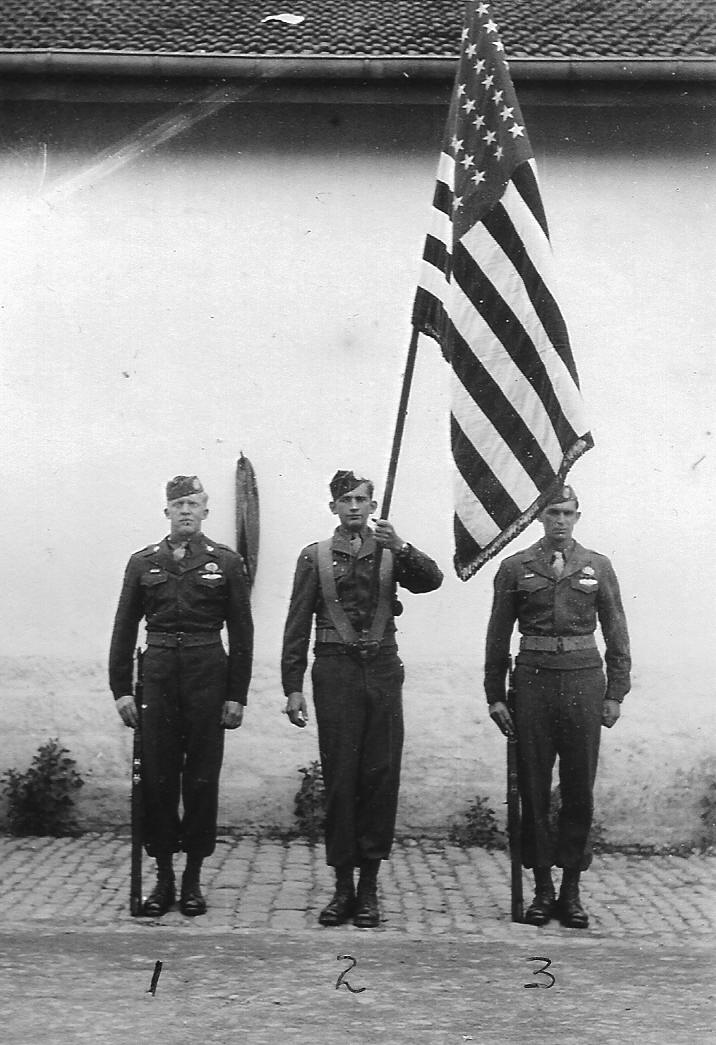
1. S/Sgt Albrect - 2.T/Sgt Bud Olson - 3. S/Sgt Hamilton, Epinal, France, January, 6 1945
July 1945, we were moved to the American Sector in Berlin. I held the job as color guard until I was discharged in November 1945. My most vivid memories of Berlin were the starving children. They would fight for our garbage and the little ones always suffered the most. I adopted (?) a small girl and fed her every day. How I wish I had taken her name… Maybe she is still alive and well.
This is my story of my experiences during WWII. A lot of this is copied out of my diary that kept. I hope it will be of some interest to anyone who reads it.
Bud C Olson
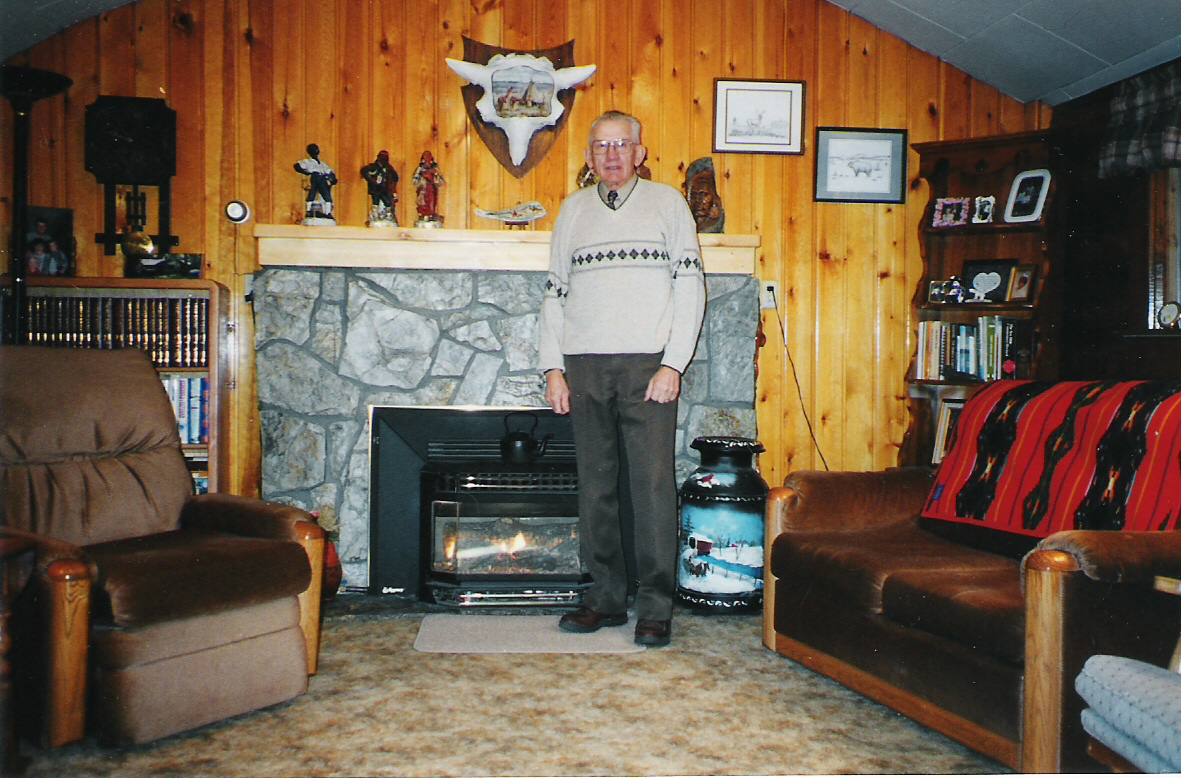
Bud Olson's house. Photo take in December 2007